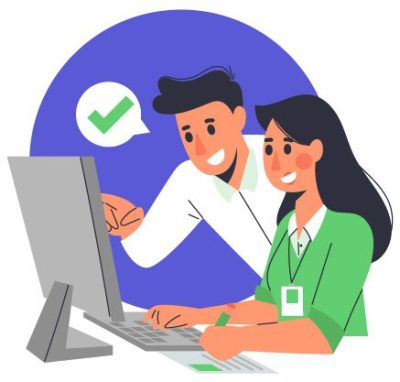ELearning simply means learning that takes place through the use of technology and digital resources viz, laptop, mobile, zoom, youtube, etc. eLearning allows students, employees in training, and casual learners to participate in organized learning experiences regardless of their physical location. With eLearning, learners can access the content from anywhere, anytime. It provides personalized content at the point of need. It saves time and money. Finally, it can lead to better knowledge retention among learners. eLearning is of two types:
- Synchronous eLearning, Virtual Classroom, Webinar, etc
- Asynchronous eLearning, pre-recorded lectures, assignments, lessons, notes, etc
The primary difference between Synchronous eLearning and Asynchronous eLearning is that the former is used to deliver content live to large geographically dispersed learners through the use of technology and resources.
A virtual classroom is an online teaching and learning environment that takes place in a live, synchronous setting. This involves live interaction between the instructor and participants in a virtual environment created using computers with internet connections, videoconferencing devices, tools, and resources, in which neither teachers nor students are physically present in the classroom. In other words, Tutors will be able to live-stream their lessons and students will be able to interact and collaborate with each other in real-time with tools and resources like a digital whiteboard, authoring tools, presentation slides, etc along with a screen-sharing facility, and other tools and resources. They are available on Zoom, youtube, or skype platforms, where you can present the course materials, engage and interact with other team members, and get feedback on the topic, etc.
Virtual Classrooms are effective due to:
– Ability to conduct classes in any location with an internet connection
– No need to rent a classroom
– Easily accessible from any computer and mobile device.
– Increased engagement
– Collaborative Learning
– Student-Centered Instruction where there is active participation between instructor and student.
– Cut the cost of training
– Scalability
– Provide instant feedback to learners
– Recording your class through cloud recording reinforces learning after class and enables you to share your class with other learners.
– Effective Cloud Storage
– Screen sharing with remote learners
– Provide compliance training assessment matrices such as proof of participation (attendance), focus on measured interactions (Level of interaction among participants), feedback, etc.,
– career advancement opportunities
Virtual classrooms can be used for any form of learning that requires an instructor to engage students in real time. You can engage in a virtual classroom session for online tutoring and distance education in Primary and Higher Education, compliance and scalable training initiatives for upskilling and reskilling employees, etc. The tools used include a digital whiteboard, which is an interactive whiteboard that enables you to sketch your ideas with learners in real-time. It includes a drawing tool, a text editor, and some formatting options. Recording your class’s session reinforces learning after class. Also, Screen sharing is a perfect way to demonstrate to remote learners how a particular task is performed. Cloud storage is the centralized place where your contents are stored and shared among learners.
Virtual classrooms are a place for open engagement and active learning. Features like a digital whiteboard, screen sharing, video playback, quizzing, etc., contribute to getting learners interested in learning. A lack of engagement and interest can lead the learners to get passive and cause overall disillusionment with the subject and cease absorbing relevant information. Hence, the facilitators and learners must interact and get the best out of the training initiatives. Virtual classrooms enable instructors to be in the same room with students spread globally. With Virtual Classrooms, the cost of training can be reduced to a great extent. During compliance training sessions, attendance reports are generated automatically when the learner joins and leaves, and record the total duration present in the classroom. You can view the chat log to review submitted questions and in-class discussions. Quiz tools can measure learners’ understanding of the subject. In this way, Virtual classrooms provide data to measure the effectiveness of the session. In a way, it is a win-win situation for the companies.
The benefits of technologies include incorporating text, graphics, audio and videos, etc that allow a high level of interactivity and are accessible worldwide. Virtual classrooms have been found to be effective in dispensing Distance Education worldwide. Studies have shown a significant influence on the use of the virtual classroom to improve the overall performance of the learner.
Setting up your online virtual classroom:
- Create your website.
- Create the content based on the curriculum, subjects, etc
- Arrange for various software, slides, content management systems (CMS), LMSs, Authoring tools, digital whiteboard, Zoom, Youtube, Skype, etc
- Select suitable templates for your page.
- Acquire cloud storage for storing, uploading, and sharing resources.
- Create social media, blogs, forums, etc to provide information about the course
- Enroll and register students for virtual classroom courses
- Select a tutor for the subjects you wish to teach.
- List the tutors available for each subject on your website.
- Connect with the tutor and schedule the batch accordingly.
- Intimate with the student about the schedule.
- Invite and manage your tutors online and allow them to conduct online courses.
- Create and manage virtual classes for your students.
- Keep a log of the tutor’s and student’s attendance.
- Get the feedback of students
The classroom environment for teaching and learning is gradually changing after the pandemic. Virtual classrooms have become a major platform for delivering live eLearning courses to students. Contrary to regular face-to-face classroom sessions, virtual classroom sessions enable you to have an interactive and engaging virtual classroom environment that supports easy access to education, minimal cost of education, and developing your career along with furthering your education. Hence, staying on task and being dedicated and self-motivated can pose a big challenge in its own way, which is why online virtual sessions are not the right choice for everybody, because you will have to put in a lot of extra effort to succeed. IBM studies have found that students learn five times more efficiently in virtual classrooms than they do in traditional face-to-face classroom learning. Today, many schools are yearning for change and are practicing both traditional classroom sessions along with online virtual classroom modes of education as part of a blended learning approach. Hence, Teachers should be trained on the development and use of virtual classrooms, students should be trained to use the virtual classroom for easy access to education and learning capabilities, and virtual classrooms should be utilized to maximize the learning process.




Please enter input field